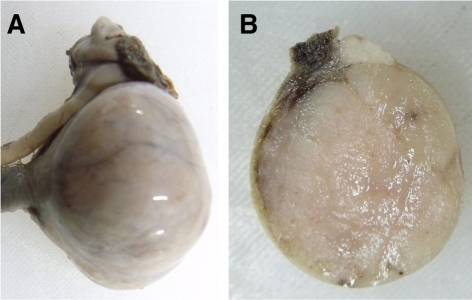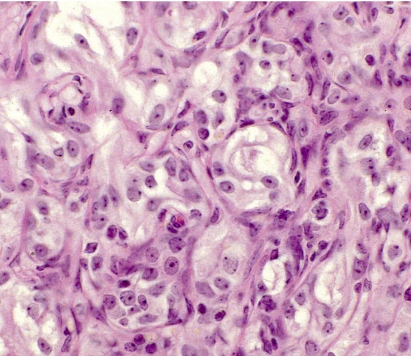Lab Anim Res.
2011 Jun;27(2):177-178. 10.5625/lar.2011.27.2.177.
Spontaneous Sertoli Cell Tumor with Cryptorchism in a Beagle Dog
- Affiliations
-
- 1Center for Animal Resources Development, Wonkwang University, Iksan, Republic of Korea. kimoj@wku.ac.kr
- 2Institute of Animal Experiment & Efficacy Evaluation, Wonkwang University, Iksan, Republic of Korea.
- 3Institute of Biotechnology, Wonkwang University, Iksan, Republic of Korea.
- KMID: 2053668
- DOI: http://doi.org/10.5625/lar.2011.27.2.177
Abstract
- A male one year-old beagle dog with unilateral cryptorchism was presented for investigation of reduced appetite. Abdominal sonography and radiography demonstrated abnormal enlargement of the left testicle in the abdominal cavity. Both the retroperitoneal cryptorchid testicle and the other contralateral testicle were removed surgically. The retroperitoneal cryptorchid testicle was an enlarged, firm and bulging sphere mass. The cut surface revealed a homogeneous white color. The contralateral testicle in the scrotum showed an almost normal appearance. Histopathologically, the retroperitoneal cryptorchid testicle was diagnosed as a Sertoli cell tumor. This report describes a case of Sertoli cell tumor with cryptorchism in a beagle dog.
Keyword
MeSH Terms
Figure
Cited by 1 articles
-
Unilateral cryptorchidism induces morphological changes of testes and hyperplasia of Sertoli cells in a dog
Joon Ho Moon, Dae Young Yoo, Young Kwang Jo, Geon A Kim, Hyo Young Jung, Jung Hoon Choi, In Koo Hwang, Goo Jang
Lab Anim Res. 2014;30(4):185-189. doi: 10.5625/lar.2014.30.4.185.
Reference
-
1. Peters MA, de Jong FH, Teerds KJ, de Rooij DG, Dieleman SJ, van Sluijs FJ. Ageing, testicular tumours and the pituitary-testis axis in dogs. J Endocrinol. 2000; 166(1):153–161. PMID: 10856894.
Article2. Weller RE, Dagle GE, Buschbom RL, Park JF. Examination of testicular tumours in the beagle dog exposed to inhaled plutonium. Int J Radiat Biol. 1995; 68(1):63–70. PMID: 7629439.
Article3. Peters MA, Teerds KJ, van der Gaag I, de Rooij DG, van Sluijs FJ. Use of antibodies against LH receptor, 3β-hydoxysteroid dehydrogenase and vimentin to characterize different types of testicular tumour in dogs. Reproduction. 2001; 121(2):287–296. PMID: 11226053.4. Nielsen SW, Kennedy PC. Moulton JE, editor. Tumors of the genital system. Tumors in Domestic Animals. 1990. 3rd ed. Berkeley: University of California Press;p. 479–513.5. Hayes HM Jr, Wilson GP, Pendergrass TW, Cox VS. Canine cryptorchism and subsequent testicular neoplasia: case-control study with epidemiologic update. Teratology. 1985; 32(1):51–56. PMID: 2863879.
Article6. Hayes HM Jr, Pendergrass TW. Canine testicular tumors: epidemiologic features of 410 dogs. Int J Cancer. 1976; 18(4):482–487. PMID: 977190.
Article7. Patnaik AK, Mostofi FK. A clinicopathologic, histologic and immunohistochemical study of mixed germ cell-stromal tumors of the testis in 16 dogs. Vet Pathol. 1993; 30(3):287–295. PMID: 8392765.
Article8. Herron MA. Tumors of the canine genital system. J Am Anim Hosp Assoc. 1983; 19(6):981–994.9. Reif JS, Brodey RS. The relationship between cryptorchidism and canine testicular neoplasia. J Am Vet Med Assoc. 1969; 155(12):2005–2010. PMID: 4391618.10. Brearley MJ. White RAS, editor. The urogenital system. Manual of Small Animal Oncology. 1991. Gloucester: British Small Animal Veterinary Association;p. 306–307.
- Full Text Links
- Actions
-
Cited
- CITED
-
- Close
- Share
- Similar articles
-
- A Case of Giant Sertoli-Leydig Cell Tumor of the Ovary with Masculinization
- Ovarian serous cystadenoma associated with Sertoli-Leydig cell tumor: a case report
- A Case of Sertoli-Leydig Cell Tumor
- Testicular Sertoli Cell Tumor in an Adult
- Sertoli cell tumors associated with feminizing syndrome and spermatic cord torsion in two cryptorchid dogs



